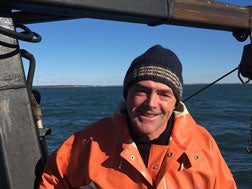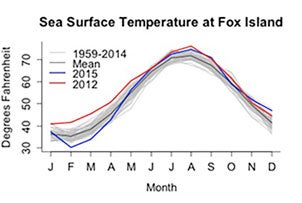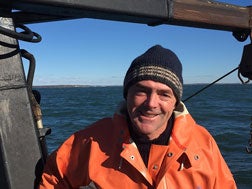 NARRAGANSETT, R.I., Jan 15, 2016—If you have any doubt that climate change is affecting our planet, consider the research of Jeremy Collie, an oceanographer at the University of Rhode Island’s Graduate School of Oceanography.
NARRAGANSETT, R.I., Jan 15, 2016—If you have any doubt that climate change is affecting our planet, consider the research of Jeremy Collie, an oceanographer at the University of Rhode Island’s Graduate School of Oceanography.
Collie says that temperatures in Narragansett Bay hit record highs and lows in 2015, which he calls the “most extreme” fluctuations observed since GSO started surveying the waters 56 years ago.
The study reveals that climate change is warming the ocean and, just as telling, causing weather extremes. El Niño, a warming in the eastern Pacific Ocean that develops typically after late December, played a role as well, he says.
“What really stands out with our findings is that we had extreme cold and extreme heat in the water temperature in 2015,” says Collie. “So even though the world is warming because of climate change, we’re still going to have these extremes.”
The findings came from GSO’s Narragansett Bay Fish Trawl, started in 1959 to sample fish every week in the Bay and track any seasonal or annual changes of marine life. Water temperature is also recorded every week at the same site off Wickford. Collie has been managing the trawl since 1998. The sampling is done by graduate assistants, including Joseph Langan, who is studying winter flounder in the Bay for his doctorate in oceanography.
 The Earth’s atmosphere has warmed by 1.5 degrees Fahrenheit since 1900, scientists say. The changes are alarming: sea levels are rising; sea ice is melting; rainfall amounts are lessening and intensifying; and oceans absorbing carbon emissions are acidifying. Ocean temperatures are also changing, with the 10 warmest years on record from 1997 to 2008.
The Earth’s atmosphere has warmed by 1.5 degrees Fahrenheit since 1900, scientists say. The changes are alarming: sea levels are rising; sea ice is melting; rainfall amounts are lessening and intensifying; and oceans absorbing carbon emissions are acidifying. Ocean temperatures are also changing, with the 10 warmest years on record from 1997 to 2008.
Collie says he has noticed a steady rise of temperatures in the Bay over the years, with a peak in 2012, the warmest year on record. The overall heating trend is accompanied by seasonal weather extremes.
Here’s what he found examining last year’s temperatures:
Following a warm January in 2015, sea surface temperature plummeted to 30 degrees Fahrenheit and parts of Narragansett Bay froze over. The record cold temperatures in February and March persisted until late April when the Bay warmed rapidly, exceeding the seasonal average.
A hot summer followed the cold winter. In October 2015, temperatures cooled toward the long-term average, but remained well above average during the last two months of the year, with some of the highest—or warmest—temperatures on record during November and December. The temperatures averaged about 50 degrees Fahrenheit during those months.
Some of the “fall heat” is probably due to a strong El Niño developing in the eastern Pacific Ocean, Collie says. But he cautions that the temperature extremes are also consistent with predictions of more intense weather events caused by climate change.
As expected, the Bay’s temperature changes influenced marine life, says Collie. Last year’s harsh winter benefited cold-water species like lobster and winter flounder, which spawn in winter to avoid predators killing their larvae. GSO’s fish trawl caught 57 lobsters in just one tow in the lower Bay. The last time more than 50 lobsters were caught in one tow was in the summer of 2009. The warmer ocean temperatures that followed brought in more warm-water species including scup, butterfish, and squid. Some of these warm-water species like menhaden have remained in the Bay during the fall.
“We’ve collected one of the longest records of ocean water temperature, which serves as a sentinel for the warming of the oceans,” says Collie. “We have this well-defined signal of what ocean life has been over the last five decades. We can use it to make predictions about how marine life will respond to future climate change.”
Collie has a doctorate in biological oceanography from the joint program offered by the Massachusetts Institute of Technology and the Woods Hole Oceanographic Institution. He is a marine ecologist concentrating on marine fish and invertebrate populations. He teaches graduate courses on fish population dynamics, fisheries oceanography, and numerical models and data analysis in ocean science.
Click here for more information about the GSO’s fish trawl.
Pictured above:
Jeremy Collie, an oceanographer at URI’s Graduate School of Oceanography. Photo by Joseph Langan.
Graph: Water temperature at Fox Island, off the Wickford coast. Graph by Jeremy Collie.

